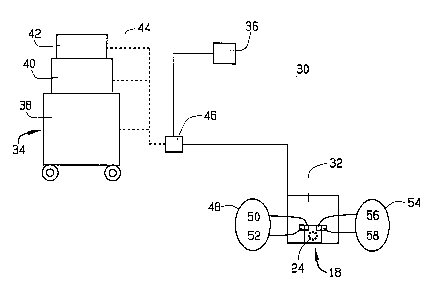Some of the information on this Web page has been provided by external sources. The Government of Canada is not responsible for the accuracy, reliability or currency of the information supplied by external sources. Users wishing to rely upon this information should consult directly with the source of the information. Content provided by external sources is not subject to official languages, privacy and accessibility requirements.
Any discrepancies in the text and image of the Claims and Abstract are due to differing posting times. Text of the Claims and Abstract are posted:
| (12) Patent: | (11) CA 2469900 |
|---|---|
| (54) English Title: | FOOT CONTROLLER WITH INTERLOCK CIRCUIT |
| (54) French Title: | PEDALE A CIRCUIT DE BLOCAGE |
| Status: | Term Expired - Post Grant Beyond Limit |
| (51) International Patent Classification (IPC): |
|
|---|---|
| (72) Inventors : |
|
| (73) Owners : |
|
| (71) Applicants : |
|
| (74) Agent: | OSLER, HOSKIN & HARCOURT LLP |
| (74) Associate agent: | |
| (45) Issued: | 2008-12-02 |
| (86) PCT Filing Date: | 2002-12-06 |
| (87) Open to Public Inspection: | 2003-07-03 |
| Examination requested: | 2004-06-10 |
| Availability of licence: | N/A |
| Dedicated to the Public: | N/A |
| (25) Language of filing: | English |
| Patent Cooperation Treaty (PCT): | Yes |
|---|---|
| (86) PCT Filing Number: | PCT/US2002/039194 |
| (87) International Publication Number: | US2002039194 |
| (85) National Entry: | 2004-06-10 |
| (30) Application Priority Data: | ||||||
|---|---|---|---|---|---|---|
|
A foot controller (32) for use with ophthalmic surgical equipment (34)
includes a foot controller (32) having a door (18). Door (18) covers a
surgical switch (24) when door (18) is in a closed position, and door (18) is
a shroud for a surgical switch (24) when door (18) is in an open position. A
door-position sensor (48) disables activation of the surgical switch (24),
except when the door is in an open position.
L'invention concerne une pédale (32) à utiliser conjointement avec un équipement chirurgical ophtalmique (34). Cette pédale (32) présente une porte (18) recouvrant un commutateur chirurgical (24) quand elle (18) se trouve dans une position fermée et protégeant celui-ci (24) quand elle (18) se trouve dans une position ouverte. Un détecteur de position de la porte (48) désactive le commutateur chirurgical (24), sauf quand la porte se trouve dans une position ouverte.
Note: Claims are shown in the official language in which they were submitted.
Note: Descriptions are shown in the official language in which they were submitted.

2024-08-01:As part of the Next Generation Patents (NGP) transition, the Canadian Patents Database (CPD) now contains a more detailed Event History, which replicates the Event Log of our new back-office solution.
Please note that "Inactive:" events refers to events no longer in use in our new back-office solution.
For a clearer understanding of the status of the application/patent presented on this page, the site Disclaimer , as well as the definitions for Patent , Event History , Maintenance Fee and Payment History should be consulted.
| Description | Date |
|---|---|
| Inactive: Expired (new Act pat) | 2022-12-06 |
| Common Representative Appointed | 2019-10-30 |
| Common Representative Appointed | 2019-10-30 |
| Inactive: IPC deactivated | 2011-07-29 |
| Grant by Issuance | 2008-12-02 |
| Inactive: Cover page published | 2008-12-01 |
| Pre-grant | 2008-09-18 |
| Inactive: Final fee received | 2008-09-18 |
| Notice of Allowance is Issued | 2008-04-02 |
| Letter Sent | 2008-04-02 |
| Notice of Allowance is Issued | 2008-04-02 |
| Inactive: IPC assigned | 2008-04-01 |
| Inactive: IPC expired | 2008-04-01 |
| Inactive: IPC removed | 2008-03-27 |
| Inactive: IPC removed | 2008-03-27 |
| Inactive: Approved for allowance (AFA) | 2007-12-12 |
| Amendment Received - Voluntary Amendment | 2007-10-18 |
| Inactive: S.30(2) Rules - Examiner requisition | 2007-06-21 |
| Amendment Received - Voluntary Amendment | 2006-08-25 |
| Letter Sent | 2006-03-13 |
| Inactive: Office letter | 2006-03-13 |
| Inactive: IPC from MCD | 2006-03-12 |
| Inactive: IPC from MCD | 2006-03-12 |
| Inactive: IPC from MCD | 2006-03-12 |
| Inactive: Inventor deleted | 2006-03-03 |
| Inactive: Inventor deleted | 2006-03-03 |
| Inactive: S.30(2) Rules - Examiner requisition | 2006-02-28 |
| Inactive: Delete abandonment | 2005-10-27 |
| Inactive: Abandoned - No reply to Office letter | 2005-09-13 |
| Correct Applicant Request Received | 2005-09-12 |
| Inactive: Single transfer | 2005-09-12 |
| Inactive: Cover page published | 2004-08-20 |
| Inactive: Courtesy letter - Evidence | 2004-08-17 |
| Inactive: Acknowledgment of national entry - RFE | 2004-08-16 |
| Letter Sent | 2004-08-16 |
| Application Received - PCT | 2004-07-09 |
| National Entry Requirements Determined Compliant | 2004-06-10 |
| Request for Examination Requirements Determined Compliant | 2004-06-10 |
| All Requirements for Examination Determined Compliant | 2004-06-10 |
| National Entry Requirements Determined Compliant | 2004-06-10 |
| Application Published (Open to Public Inspection) | 2003-07-03 |
There is no abandonment history.
The last payment was received on 2008-10-02
Note : If the full payment has not been received on or before the date indicated, a further fee may be required which may be one of the following
Patent fees are adjusted on the 1st of January every year. The amounts above are the current amounts if received by December 31 of the current year.
Please refer to the CIPO
Patent Fees
web page to see all current fee amounts.
Note: Records showing the ownership history in alphabetical order.
| Current Owners on Record |
|---|
| BAUSCH & LOMB INCORPORATED |
| Past Owners on Record |
|---|
| MICHAEL E. METZLER |
| ROBERT ALLYN |
| WILLIAM J. NEUBERT |